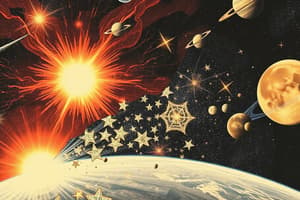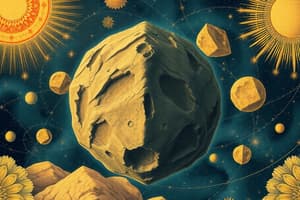Podcast
Questions and Answers
What is the majority of the Solar System's mass contained in?
What is the majority of the Solar System's mass contained in?
- The Sun (correct)
- Neptune
- Jupiter
- Saturn
Which type of planets are primarily composed of rock and metal?
Which type of planets are primarily composed of rock and metal?
- Terrestrial planets (correct)
- Dwarf planets
- Ice giants
- Gas giants
What are the two outermost planets, Uranus and Neptune, mainly composed of?
What are the two outermost planets, Uranus and Neptune, mainly composed of?
- Hydrogen and helium
- Water and methane (correct)
- Hydrogen and methane
- Ammonia and water
What are the smaller objects in the Solar System collectively referred to as?
What are the smaller objects in the Solar System collectively referred to as?
Where did the Solar System form from?
Where did the Solar System form from?
Which type of planets are substantially more massive than the terrestrial planets?
Which type of planets are substantially more massive than the terrestrial planets?
What is the majority of the remaining mass in the Solar System contained in?
What is the majority of the remaining mass in the Solar System contained in?
Which two planets are composed mainly of hydrogen and helium?
Which two planets are composed mainly of hydrogen and helium?
What are the small Solar System bodies collectively referred to as?
What are the small Solar System bodies collectively referred to as?
Where did the Solar System form from?
Where did the Solar System form from?
Flashcards are hidden until you start studying
Study Notes
The Solar System
- The majority of the Solar System's mass is contained in the Sun.
Planets
- Terrestrial planets are primarily composed of rock and metal.
Gas Giants
- The two outermost planets, Uranus and Neptune, are mainly composed of ice.
- The gas giants, Jupiter and Saturn, are substantially more massive than the terrestrial planets.
Small Bodies
- Smaller objects in the Solar System are collectively referred to as small Solar System bodies or smaller bodies.
Formation of the Solar System
- The Solar System formed from a giant cloud of gas and dust called the solar nebula.
Gas Giants Composition
- The majority of the remaining mass in the Solar System is contained in the gas giants, Jupiter and Saturn, which are composed mainly of hydrogen and helium.
Small Bodies Terminology
- Small Solar System bodies are collectively referred to as planetary objects or small bodies.
Studying That Suits You
Use AI to generate personalized quizzes and flashcards to suit your learning preferences.




